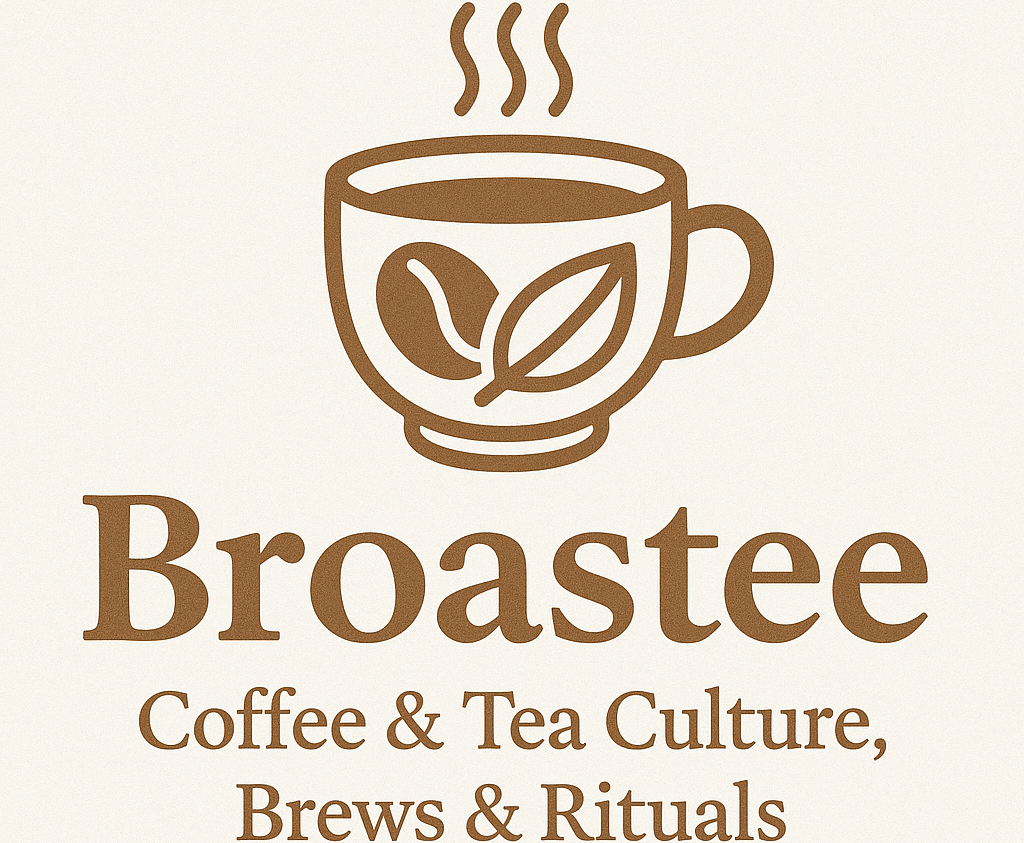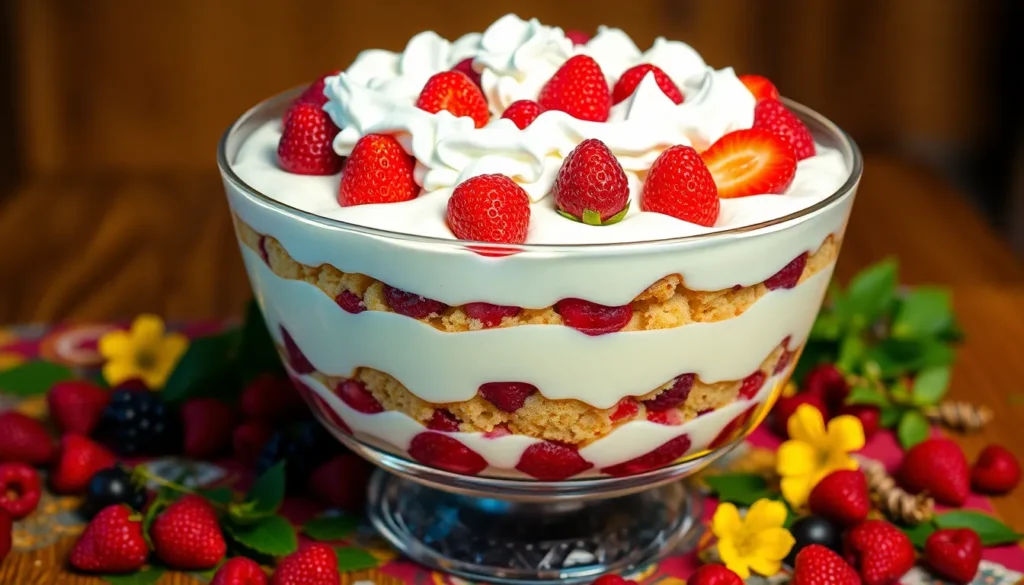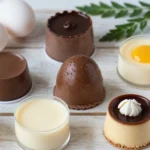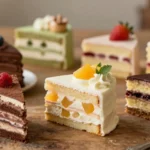Trifle transforms simple ingredients into an extraordinary dessert that’ll have your guests asking for seconds. This classic British dessert layers sponge cake, custard, fruit, and whipped cream to create a stunning centerpiece that’s as beautiful as it is delicious.
We love how versatile trifles can be – you can customize every layer to match your taste preferences or seasonal ingredients. Whether you’re craving a traditional sherry trifle or want to experiment with chocolate, berry, or tropical flavors, there’s a combination that’ll satisfy your sweet tooth.
The best part? Trifles actually taste better when made ahead of time. The flavors meld together beautifully overnight, making this the perfect make-ahead dessert for dinner parties, holidays, or any time you want to impress without the last-minute stress. Let’s jump into some show-stopping trifle recipes that’ll become your new go-to desserts.
What Is a Trifle
A trifle represents one of Britain’s most beloved layered desserts that combines multiple textures and flavors in a beautiful glass bowl or dish. We define this classic dessert as a harmonious assembly of sponge cake or ladyfingers, custard or pudding, fresh or preserved fruit, and whipped cream arranged in distinct visible layers.
The traditional trifle structure follows a exact pattern that creates both visual appeal and balanced flavors. Sponge cake forms the foundation layer, often soaked with sherry, fruit juice, or liqueur to add moisture and depth. Custard provides the creamy middle layer that binds the dessert together while adding richness. Fresh berries, canned fruit, or jam contribute natural sweetness and vibrant color. Whipped cream crowns the creation with its light and airy texture.
We appreciate how trifles showcase their ingredients through transparent glass containers, making the colorful layers a focal point of presentation. Each spoonful delivers a perfect combination of cake, cream, fruit, and custard that creates a satisfying dessert experience.
The beauty of trifles lies in their flexibility and forgiving nature. We can substitute different cake types, vary the fruit selections based on seasonal availability, and adjust sweetness levels to personal preference. Alcohol content remains optional, making trifles suitable for all ages and occasions.
Assembly requires no baking skills once the individual components are prepared or purchased. We simply layer each element in order, allowing the flavors to meld together in the refrigerator. This make ahead quality makes trifles perfect for entertaining since they actually improve in taste and texture after several hours of chilling.
Essential Equipment for Making Trifles
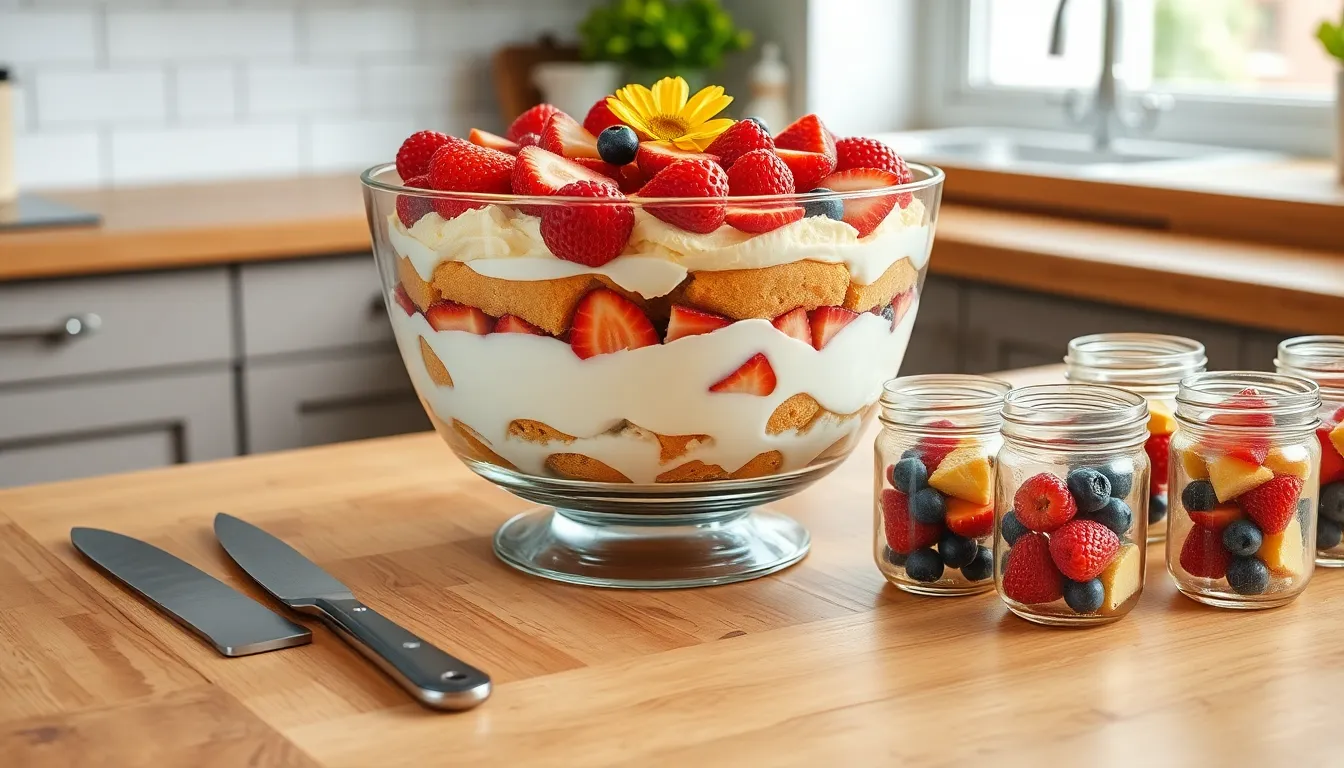
Creating beautiful trifles requires minimal equipment, making them accessible to home cooks of all skill levels. We’ve compiled the essential tools that will help you create stunning layered desserts with ease.
Large Glass Bowl serves as the centerpiece for your trifle presentation. This transparent vessel showcases each colorful layer and allows guests to admire your handiwork before diving in. A bowl with straight or slightly flared sides works best for creating defined layers.
Mason Jars offer an excellent alternative for individual servings. These portable containers create charming mini trifles perfect for parties or portion control. We recommend using wide-mouth jars for easier assembly and eating.
Sharp Knife becomes essential for cutting your cake base into uniform pieces. Clean cuts ensure professional-looking layers and prevent crumbling that can muddle your trifle’s appearance.
Rubber Spatula helps spread creams and custards evenly across each layer. This tool prevents air bubbles and creates smooth, uniform surfaces that contribute to your trifle’s polished appearance.
Wire Whisk transforms heavy cream into fluffy peaks for your trifle’s crowning layer. Hand whisking gives you better control over texture, though an electric mixer works equally well for larger batches.
| Equipment | Primary Use | Alternative Options |
|---|---|---|
| Large Glass Bowl | Main serving vessel | Clear plastic bowl, ceramic dish |
| Mason Jars | Individual portions | Small glasses, ramekins |
| Sharp Knife | Cutting cake layers | Serrated bread knife |
| Rubber Spatula | Spreading creams | Large spoon, offset spatula |
| Wire Whisk | Whipping cream | Electric mixer, fork |
Having these basic tools on hand ensures your trifle assembly goes smoothly and produces restaurant-quality results every time.
Basic Trifle Components
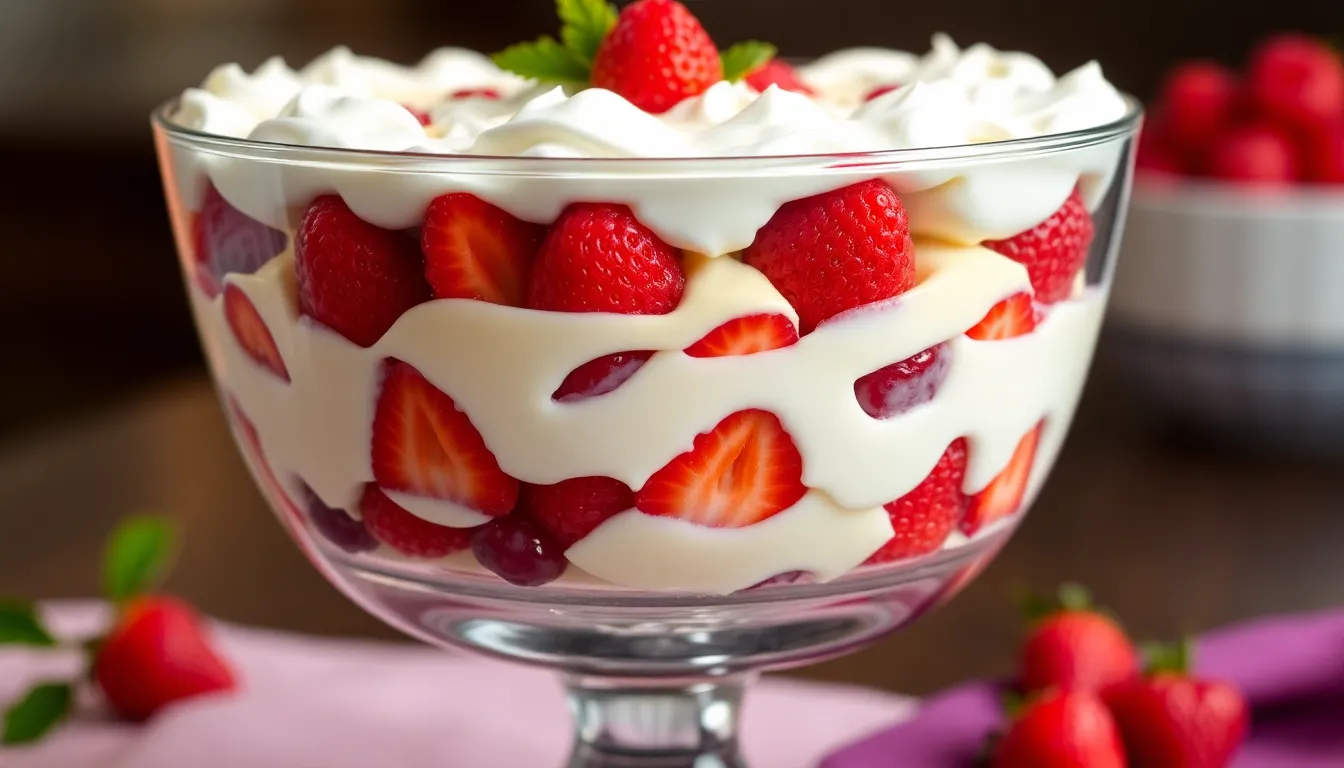
Every memorable trifle starts with understanding its fundamental building blocks. We’ll explore each essential layer that creates the perfect balance of flavors and textures.
Cake or Sponge Layer
The foundation of any trifle begins with the cake layer. We typically use sponge cake, ladyfingers, or pound cake as our base, though leftover white or yellow cake works wonderfully too. This layer gains complexity when we soak it in alcohol like sherry or Grand Marnier to enhance the overall flavor profile. The cake should be cut into manageable pieces that fit well in your serving dish while maintaining enough structure to support the layers above.
Custard or Cream Layer
Our custard layer provides the creamy richness that makes trifles irresistible. We can prepare traditional custard using egg yolks, milk, sugar, and cornstarch for a homemade approach. For those seeking convenience, Bird’s Custard powder offers a simpler alternative that delivers consistent results. Creme anglaise serves as another excellent option when we want to achieve a richer, more luxurious custard layer that elevates the entire dessert.
Fruit Layer
Fresh fruit brings vibrant color and natural sweetness to our trifle. We commonly rely on fresh berries such as strawberries and raspberries for their perfect balance of tartness and sweetness. Jam or preserves can complement the fresh fruit layer, adding concentrated flavor and additional sweetness that binds beautifully with the other components. The fruit layer should be generous enough to create visual impact while providing bursts of fresh flavor throughout each serving.
Toppings
Whipped cream crowns our trifle as the standard finishing touch. We sweeten it with powdered sugar to achieve the perfect level of sweetness without overwhelming the other flavors. Additional toppings such as more fresh fruit or nuts can be incorporated for extra texture and visual appeal. These final elements should complement rather than compete with the carefully balanced layers beneath them.
Classic English Trifle Recipe
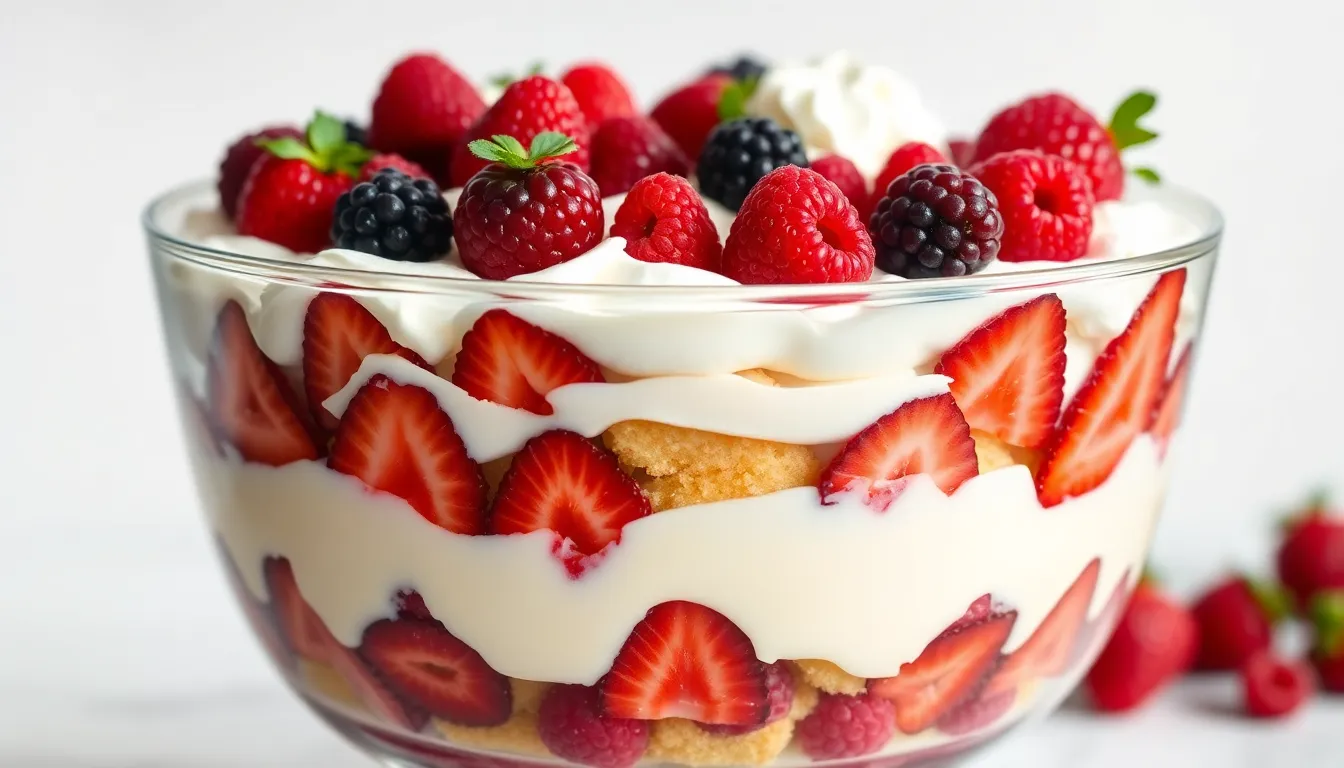
This traditional English trifle recipe delivers authentic flavors through carefully layered components that create a stunning dessert. We’ll guide you through creating this timeless treat that has graced British tables for generations.
Ingredients
Cake Layer:
- 1 (9×13 inch) white or yellow cake, baked and cooled
- 1/2 cup cream sherry
- 3 heaping tablespoons seedless red raspberry jam or preserves
Fruit Layer:
- 2 cups sliced fresh strawberries
- 1 cup fresh raspberries
- 1 tablespoon cream sherry
- 1 tablespoon sugar
Custard Layer:
- 4 cups whole milk
- 8 egg yolks
- 1/2 cup sugar
- 4 tablespoons cornstarch
- 1 1/2 teaspoons vanilla extract
- 1/2 cup butter (optional: use Bird’s Custard powder as alternative)
Whipped Cream:
- 1 1/2 cups heavy whipping cream
- 1 teaspoon powdered sugar
Instructions
Prepare the Cake Base:
Slice the cooled cake into small, uniform pieces using a sharp knife. Brush each piece with cream sherry and spread raspberry jam evenly across the surface. Set aside to allow the flavors to absorb.
Mix the Fruit:
Combine sliced strawberries and fresh raspberries in a bowl with cream sherry and sugar. Toss gently to coat the fruit evenly and let macerate for 10 minutes.
Make the Custard:
Whisk together milk, egg yolks, sugar, and cornstarch in a heavy-bottomed saucepan. Cook over medium heat while stirring constantly until the mixture thickens and coats the back of a spoon. Remove from heat and stir in vanilla extract and butter until smooth.
Assemble Your Trifle:
Layer the soaked cake pieces in the bottom of a large glass bowl. Spoon the fruit mixture over the cake layer, then pour the warm custard over the fruit. Repeat these layers until all ingredients are used, ending with a custard layer on top.
Add the Whipped Cream:
Whip heavy cream with powdered sugar until stiff peaks form. Spread the whipped cream generously over the final custard layer, creating attractive peaks with your spatula.
Chill and Serve:
Refrigerate the assembled trifle for at least 30 minutes before serving to allow flavors to meld. For best results, we recommend chilling for 2-4 hours. Garnish with additional fresh berries or almonds before presenting to your guests.
Berry Trifle Recipe
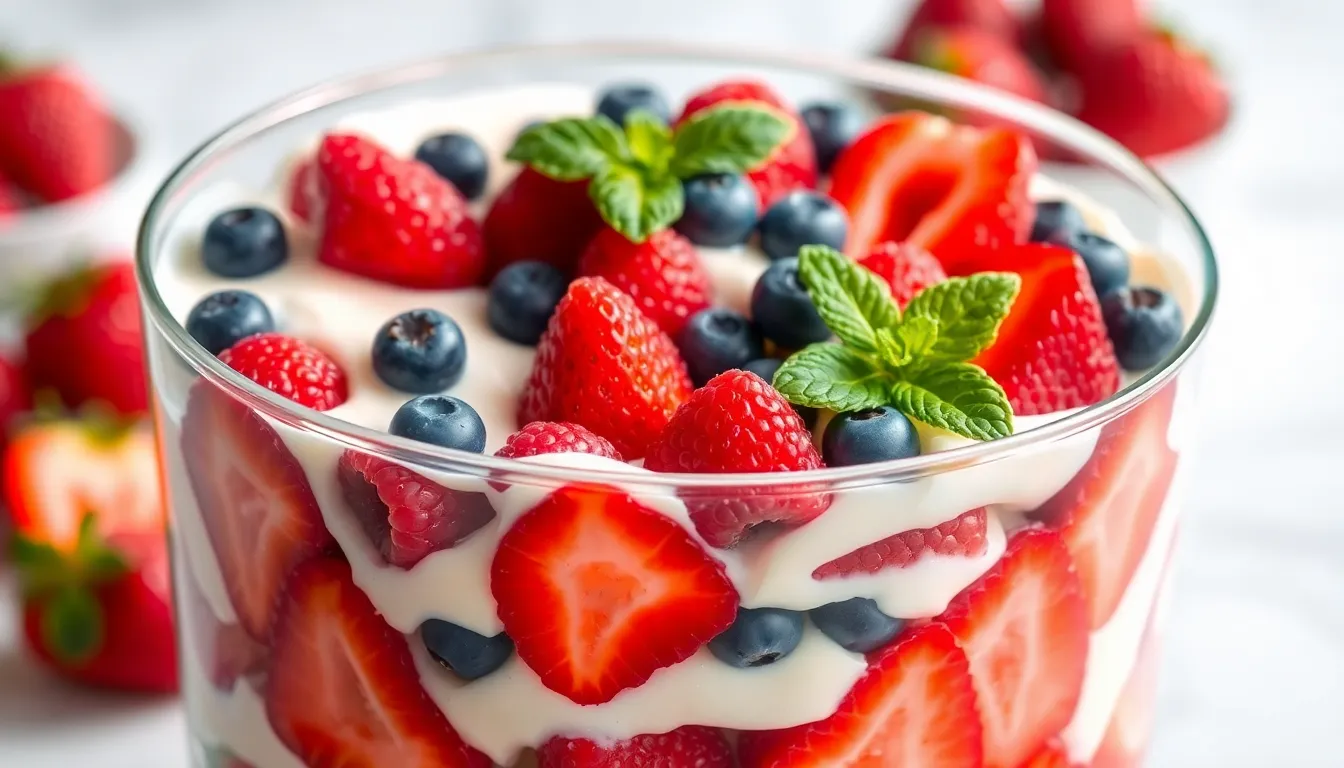
We love this fresh berry trifle for its vibrant colors and perfect balance of sweet and tart flavors. This elegant dessert combines layers of cake, luscious cream, and seasonal berries for a stunning presentation.
Ingredients
For the Berry Mixture:
- 1/2 cup raspberry jam
- 2 cups sliced fresh strawberries
- 1 cup fresh raspberries
- 1 cup fresh blueberries
- 3 tablespoons honey
- 2 tablespoons fresh lemon juice
- 1 tablespoon lemon zest
For the Cream Cheese Filling:
- 8 oz cream cheese, softened
- 1 cup heavy cream, chilled
- 1/2 cup powdered sugar
- 2 teaspoons vanilla extract
For the Base:
- 1 package ladyfingers (7 oz) or 1 angel food cake (13-16 oz), cubed
- Fresh mint leaves for garnish (optional)
Instructions
Prepare the Berry Mixture:
Heat raspberry jam in a small saucepan over low heat until warm and smooth. Remove from heat and gently fold in sliced strawberries, raspberries, and blueberries. Drizzle honey and lemon juice over the berry mixture, then sprinkle with lemon zest. Set aside to allow flavors to meld.
Make the Cream Cheese Filling:
Beat softened cream cheese in a large bowl until smooth and fluffy. Gradually add powdered sugar and vanilla extract, beating until well combined. In a separate bowl, whip heavy cream until stiff peaks form. Gently fold whipped cream into the cream cheese mixture until fully incorporated.
Assemble the Trifle:
Arrange a layer of ladyfingers or angel food cake cubes in the bottom of a large glass bowl or individual serving glasses. Spoon half of the berry mixture over the cake layer, allowing juices to soak into the cake. Add half of the cream cheese mixture, spreading evenly with a rubber spatula. Repeat layers once more, ending with a final layer of cream cheese mixture.
Chill and Serve:
Cover trifle with plastic wrap and refrigerate for at least 4 hours or overnight to allow layers to set and flavors to develop. Garnish with fresh berries and mint leaves before serving. Serve chilled for the best texture and flavor experience.
Chocolate Trifle Recipe
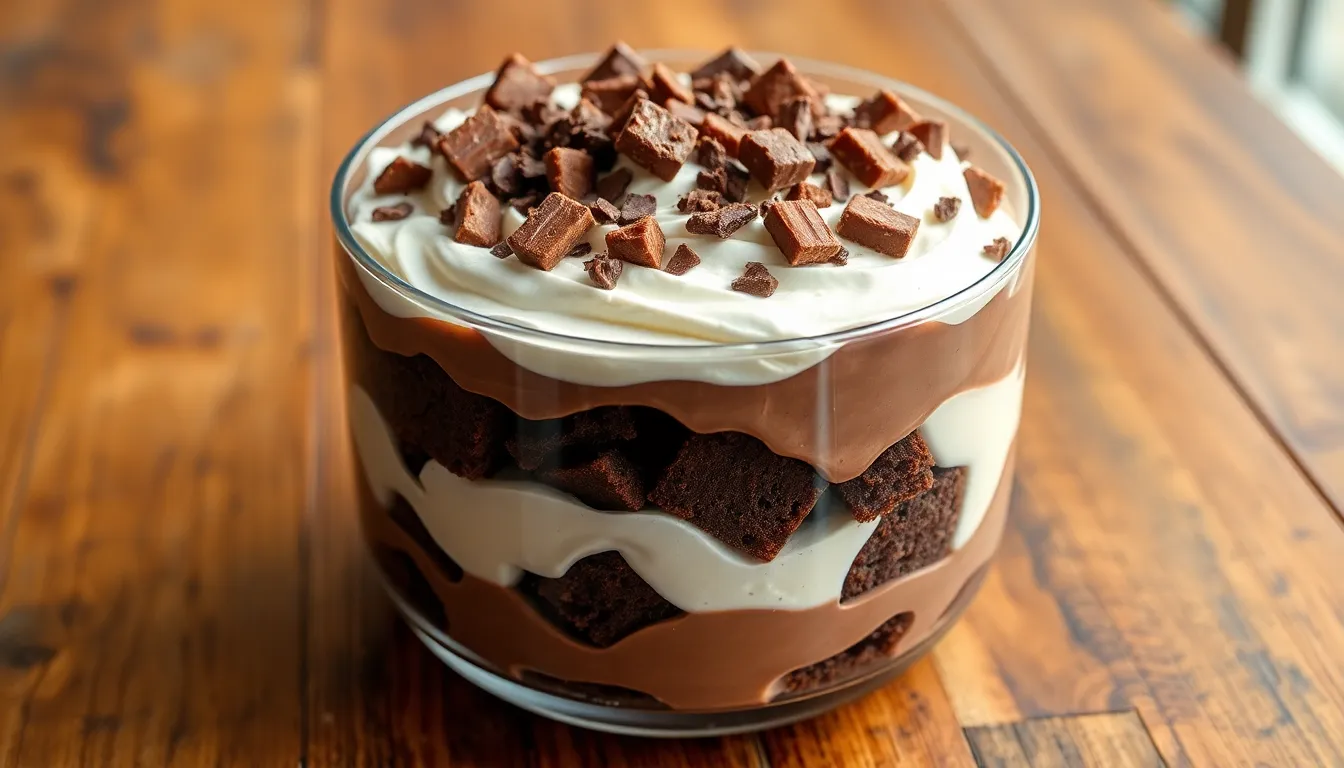
Our chocolate trifle recipe brings together rich brownie layers, velvety chocolate pudding, and fluffy whipped cream for an irresistible dessert. This decadent version transforms the classic trifle into a chocolate lover’s dream.
Ingredients
For the Brownie Base:
- 1 (20-oz.) box dark chocolate brownie mix
- 1 large egg
- 1/2 cup canola oil
- 1/4 cup water
For the Chocolate Pudding Layer:
- 3 cups chocolate pudding (homemade or store-bought)
- 1 package instant chocolate pudding mix (if making fresh)
- 2 cups whole milk (if making fresh pudding)
For the Whipped Cream:
- 1 pint heavy whipping cream
- 1/4 cup powdered sugar
For the Toppings:
- 4-5 Heath candy bars, crushed
- Chocolate candy or toffee bits
- 1 container frozen whipped topping (optional alternative)
Instructions
Prepare the Brownie Layer:
Bake the brownies according to package instructions using the egg, canola oil, and water. Allow brownies to cool completely before cutting into small cubes. Set aside prepared brownie pieces for assembly.
Make the Chocolate Pudding:
Prepare the chocolate pudding by whisking the instant pudding mix with 2 cups of whole milk until thickened. Alternatively, use store-bought chocolate pudding for convenience. Chill the pudding until ready to assemble.
Whip the Cream:
Beat heavy whipping cream with powdered sugar using an electric mixer until stiff peaks form. The whipped cream should hold its shape when the beaters are lifted.
Assemble the Trifle:
Place a layer of brownie cubes in the bottom of your trifle bowl. Spread a layer of chocolate pudding over the brownies. Add a layer of whipped cream over the pudding. Sprinkle crushed Heath candy bars over the cream layer.
Create Additional Layers:
Repeat the layering process two more times, finishing with a final layer of whipped cream on top. Garnish the top layer with additional crushed candy bars and chocolate bits for visual appeal.
Chill and Serve:
Refrigerate the assembled chocolate trifle for 1-2 hours before serving to allow flavors to meld together. The chilling time helps the layers set properly and enhances the overall taste of the dessert.
Lemon Trifle Recipe
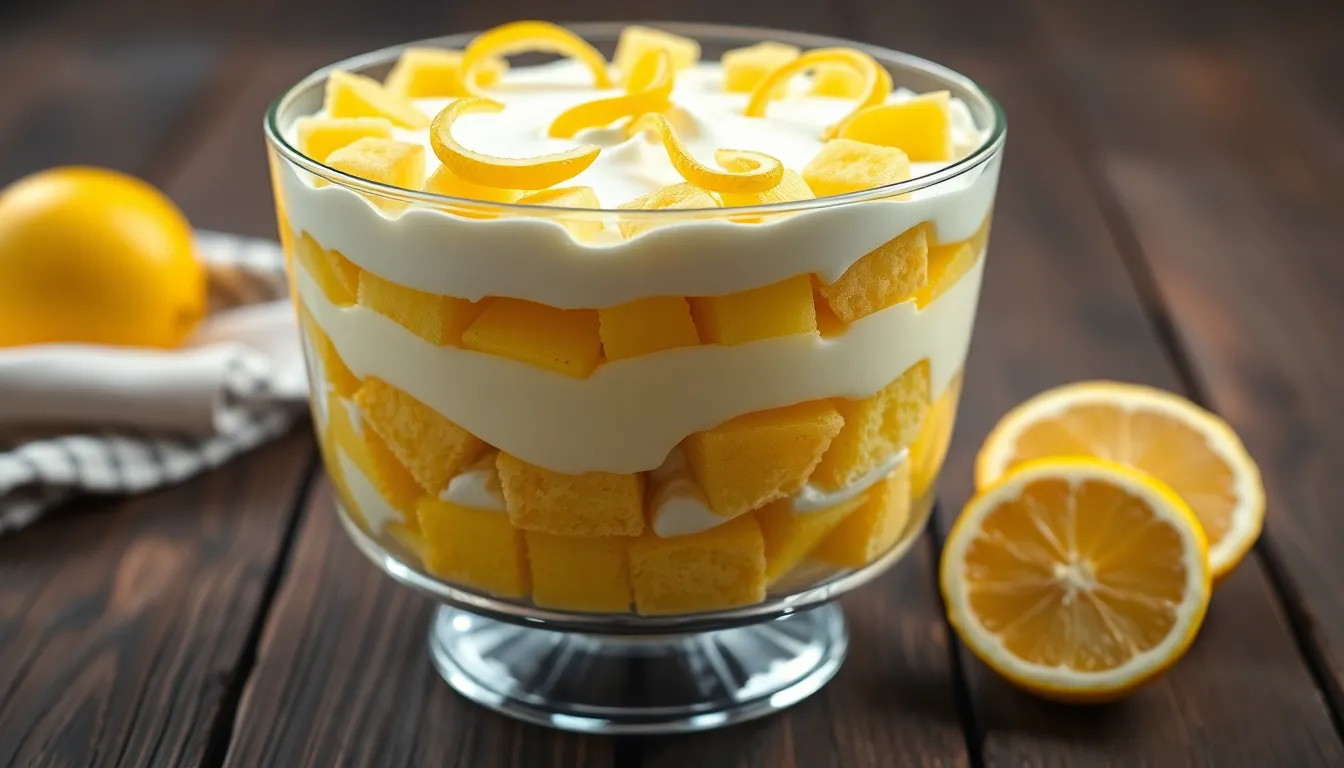
Our lemon trifle combines zesty citrus flavors with layers of tender cake and creamy textures. This bright dessert offers a perfect balance of sweet and tart elements that will refresh your palate.
Ingredients
For the Lemon Cake:
- 1 box lemon cake mix
- 2 tablespoons lemon zest (divided)
- Ingredients called for on cake mix box (eggs, oil, water)
For the Lemon Jello Mixture:
- 1 package lemon Jello (3 ounces)
- 2 cups boiling water
- 1 cup powdered sugar
For the Lemon Cream:
- 2 cups heavy whipping cream
- 12 ounces Cool Whip, thawed
- Optional lemon peel for garnish
Instructions
Prepare the Lemon Cake Base:
Bake the lemon cake according to box directions while adding 1 tablespoon of lemon zest to the batter for extra citrus flavor. Allow the cake to cool completely before cutting into small 1-inch cubes. Set the cubes aside for assembly.
Create the Lemon Jello Mixture:
Whisk together the lemon Jello powder, boiling water, and powdered sugar until completely dissolved. Refrigerate this mixture for 1 hour until it reaches a slightly thickened consistency.
Make the Lemon Cream Layer:
Beat the heavy whipping cream with an electric mixer until it begins to form soft peaks and mounds. Gently fold in 8 ounces of the thawed Cool Whip along with the remaining tablespoon of lemon zest until well combined.
Assemble the Trifle:
Layer half of the cake cubes in the bottom of your trifle dish or large glass bowl. Spread half of the lemon cream mixture over the cake layer. Add the remaining cake cubes as the next layer. Top with the remaining lemon cream mixture and finish with the remaining 4 ounces of Cool Whip. Garnish with thin strips of lemon peel if desired.
Chill and Serve:
Refrigerate the assembled trifle for at least 2 hours before serving to allow the flavors to meld together. The cake will absorb some moisture from the cream layers while maintaining its structure.
Individual Trifle Cups
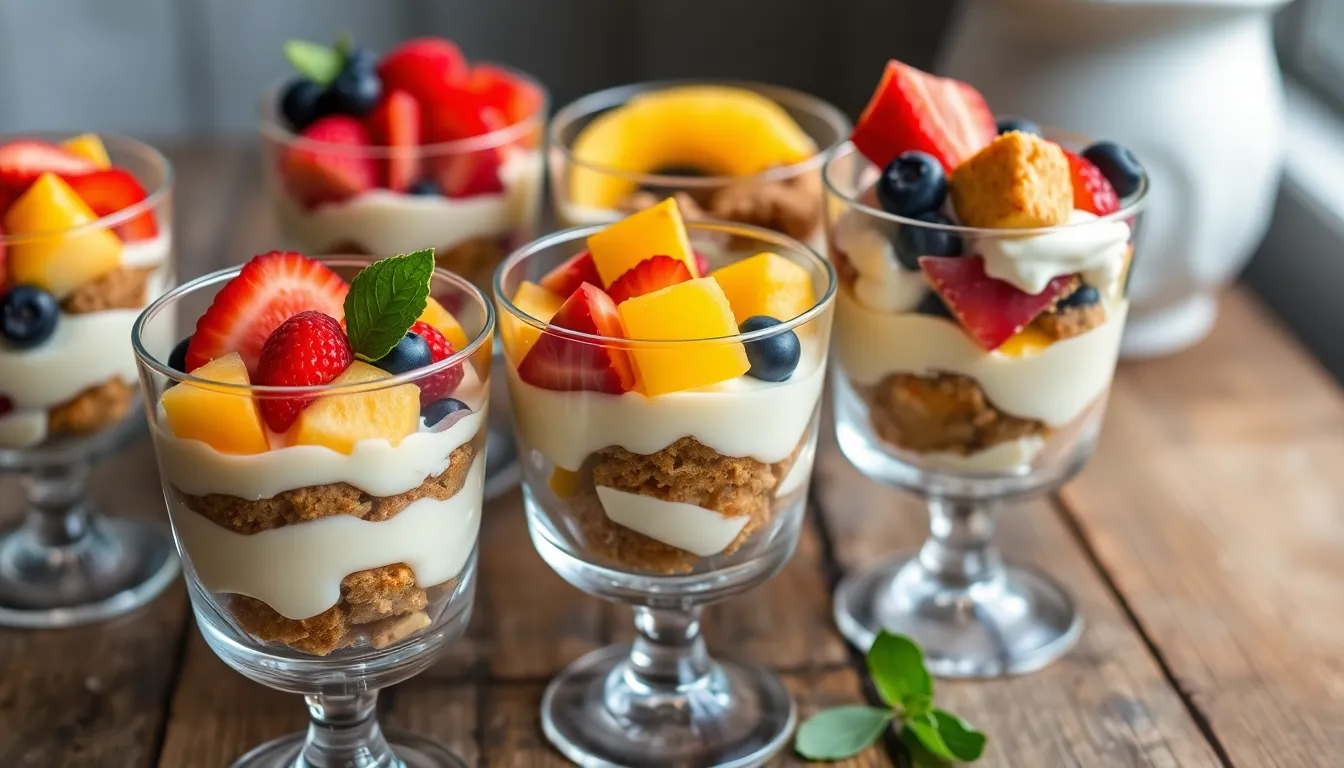
Individual trifle cups transform our beloved layered dessert into perfectly portioned servings that showcase beautiful layers in charming personal presentations. These miniature versions offer the same delightful combination of flavors while providing elegant individual servings perfect for entertaining guests.
Ingredients
For Death by Chocolate Trifle Cups:
- Brownies (homemade or store-bought)
- Boxed chocolate mousse mix
- Water (as required by mousse mix)
For Perfect Individual Trifle Cups:
- 2 cups thick custard
- 1 cup fresh strawberries
- 1 cup fresh raspberries
- 2 tablespoons jam (optional)
- 8 individual sponge cakes
- Sherry (optional)
- Pistachios (optional)
For Red Velvet Trifle Cups:
- Red velvet cake mix
- Buttermilk or water (as required by cake mix)
- Eggs (as required by cake mix)
- Oil (as required by cake mix)
- Whipped cream
For Berries & Cream Mini Trifles:
- Round cake pieces
- Jam or preserves
- Fresh berries
- Whipped cream
For Mini Caramel Trifles:
- Caramel sauce
- Heavy cream
- Powdered sugar
- Vanilla extract
- Crushed graham crackers
- Mini chocolate chips
Instructions
Death by Chocolate Trifle Assembly:
- Bake brownies according to package directions and allow them to cool completely
- Break cooled brownies into small bite-sized chunks
- Prepare chocolate mousse following box instructions until smooth and creamy
- Layer brownie chunks and chocolate mousse alternately in individual serving cups
Perfect Individual Trifle Assembly:
- Place fresh raspberries in the bottom of each individual cup
- Add one sponge cake on top of the raspberries
- Drizzle sherry over the sponge cake if desired for extra flavor
- Spoon thick custard over the soaked cake layer
- Sprinkle pistachios on the custard layer if using
- Top with jam-soaked strawberries
- Repeat sponge cake and custard layers to create height
Red Velvet Trifle Cup Assembly:
- Prepare red velvet cake according to package directions using buttermilk or water
- Allow cake to cool completely before cutting into small uniform pieces
- Layer red velvet cake pieces with generous amounts of whipped cream in individual cups
- Alternate layers until cups are filled to desired height
Berries & Cream Mini Trifle Assembly:
- Spread jam or preserves evenly on one round cake piece
- Place another cake piece on top to create a jam sandwich
- Add a layer of whipped cream over the cake sandwich
- Top with fresh berries for color and natural sweetness
- Whip heavy cream with powdered sugar and vanilla extract until soft peaks form
- Layer crushed graham crackers in the bottom of individual glasses
- Add a layer of whipped cream mixture over the graham crackers
- Sprinkle mini chocolate chips over the cream layer
- Drizzle caramel sauce generously over the chocolate chips
- Chill assembled trifles in the refrigerator for 2 hours before serving
Make-Ahead Tips for Trifles
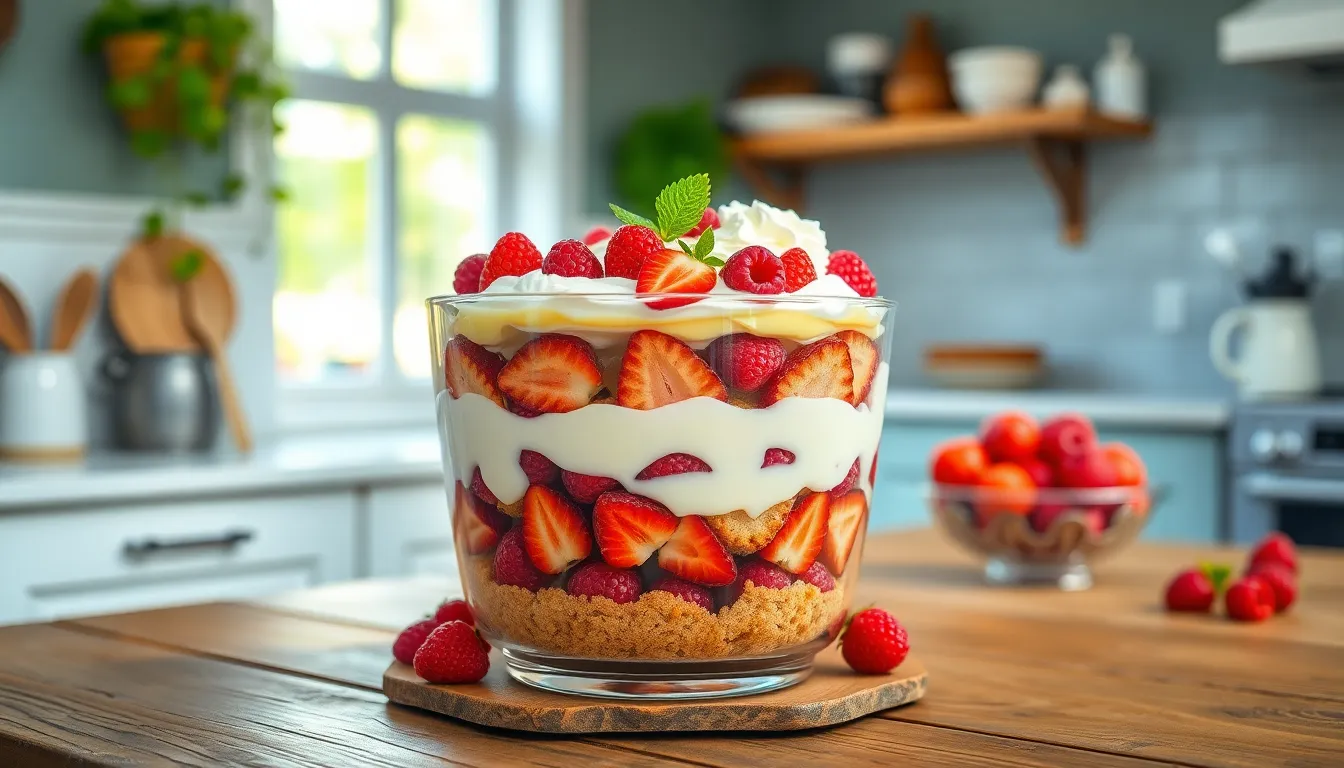
One of the greatest advantages of making trifles is their ability to be prepared ahead of time, which actually enhances their flavor and makes entertaining much easier. We recommend starting your trifle preparation up to 24 hours before serving for optimal results.
Cake Layer Preparation
Bake and cool your cake layer a full day in advance. This allows the cake to settle and develop better texture for soaking up flavors. Store the cooled cake wrapped tightly in plastic wrap at room temperature until ready to use.
Custard Component Timing
Prepare your custard layer the day before your event and refrigerate it properly. Whether using Bird’s Custard powder or making homemade custard with milk, egg yolks, sugar, and vanilla, advance preparation ensures the custard sets to the perfect consistency. Cover the custard with plastic wrap pressed directly onto the surface to prevent a skin from forming.
Strategic Assembly Approach
Assemble your trifle just before serving for the most impressive presentation. The layers maintain their distinct appearance when freshly assembled, though you can complete the assembly up to 4 hours ahead if needed. Refrigerate the assembled trifle immediately after completion.
Fruit Layer Considerations
Prepare fresh strawberries and raspberries on the morning of serving to maintain their vibrant color and firm texture. Pat berries dry before layering to prevent excess moisture from affecting other components.
Whipped Cream Timing
Make your whipped cream topping no more than 2 hours before final assembly. Heavy cream whipped with powdered sugar holds its structure best when prepared close to serving time. Store covered in the refrigerator until ready to use.
Final Assembly Schedule
Layer your pre-prepared components in this order: soaked cake and jam, fruit layer, custard, and finally whipped cream. The trifle benefits from at least 2 hours of chilling time after assembly, allowing flavors to meld beautifully while maintaining structural integrity.
Storage and Serving Guidelines
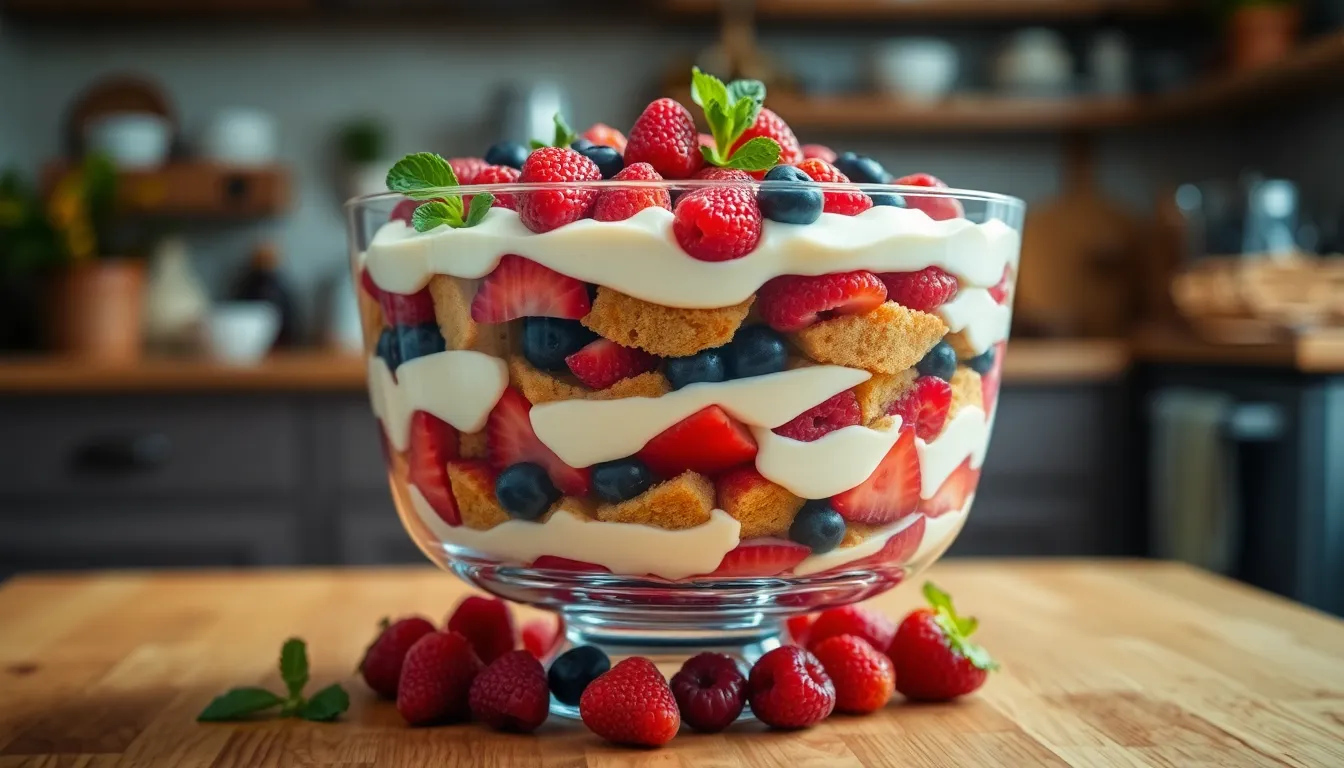
Proper storage ensures our trifle maintains its beautiful layers and fresh flavors throughout the serving period. We recommend assembling the complete trifle no more than 24 hours before serving to preserve the cake’s texture and prevent soggy layers. The finished dessert should be covered tightly with plastic wrap and refrigerated at temperatures between 35-40°F.
Optimal Storage Timing
| Component | Storage Duration | Best Practice |
|---|---|---|
| Assembled Trifle | 2-3 days maximum | Cover tightly, refrigerate immediately |
| Individual Components | Up to 2 days | Store separately until assembly |
| Whipped Cream Layer | Same day service | Add just before serving for best texture |
We find that trifles actually improve in flavor after several hours of chilling as the layers meld together harmoniously. But, we must balance this flavor development with maintaining structural integrity. The cake layer begins absorbing moisture from adjacent layers after 12 hours, which can compromise the distinct layering effect we desire.
Professional Serving Techniques
Our serving approach depends entirely on the presentation vessel we’ve chosen. Traditional trifle bowls showcase the colorful layers through clear glass sides, requiring us to use a large serving spoon that reaches the bottom. We recommend scooping straight down through all layers to ensure each portion contains every component.
Individual glasses or mason jars eliminate the serving challenge completely while providing elegant portion control. These single serving vessels allow guests to enjoy the trifle without disturbing the beautiful layering for others. We typically fill these containers leaving half an inch of space at the top for final garnishes.
Temperature and Presentation Considerations
The ideal serving temperature for trifle falls between 38-42°F, which we achieve by removing it from refrigeration just 10 minutes before service. This slight warming allows the flavors to open up while maintaining the cream’s stability. We always add final garnishes like fresh berries, mint leaves, or chocolate shavings immediately before presenting to guests.
Room temperature exposure should never exceed two hours for food safety reasons. During longer events, we keep the trifle chilled and bring out individual portions as needed rather than leaving the entire dessert at room temperature.
Creative Trifle Variations
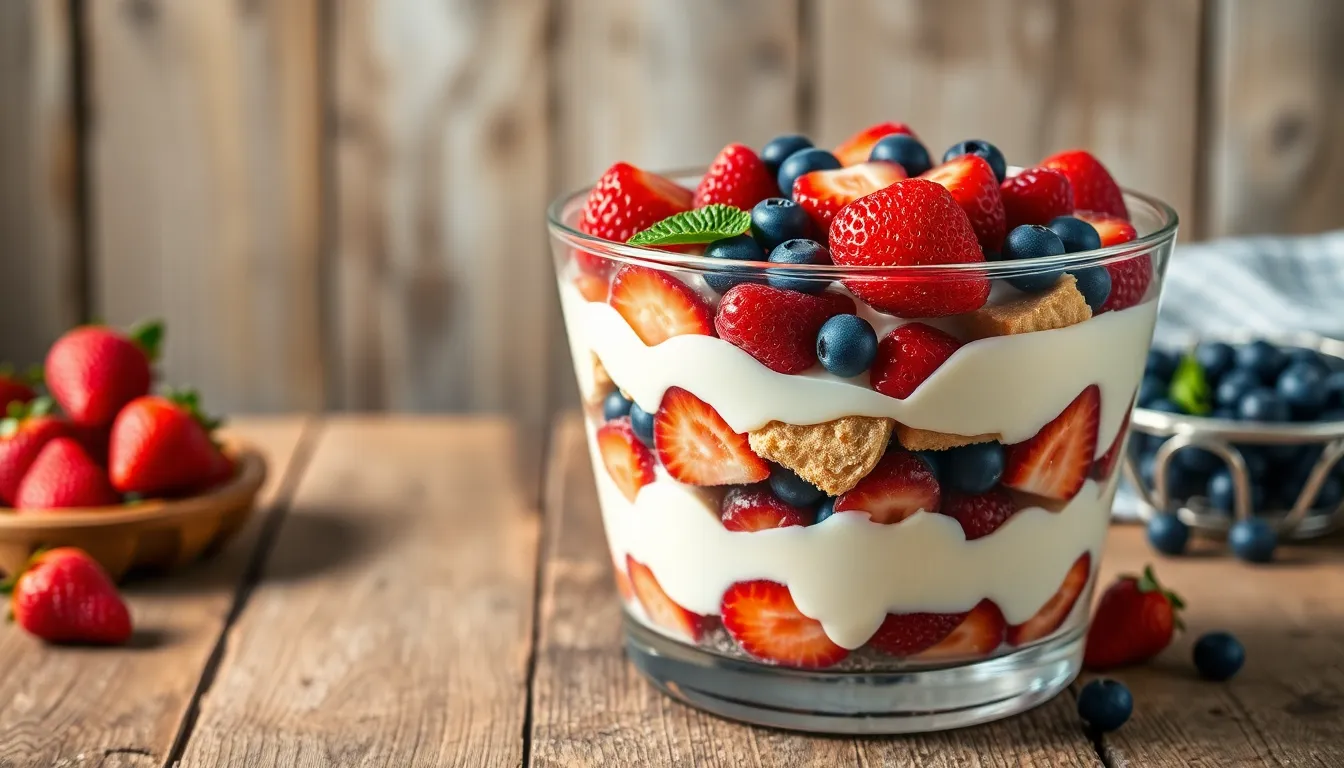
Transforming the classic trifle opens endless possibilities for customization and seasonal adaptations. We can elevate this traditional dessert by exploring different ingredients that match our taste preferences and special occasions.
Seasonal Fruit Options
Summer brings us the perfect opportunity to showcase fresh berries at their peak flavor. We recommend using strawberries, raspberries, blueberries, and blackberries for vibrant layers that burst with natural sweetness and color.
Autumn calls for heartier fruit selections that complement the changing season. Cranberries add tartness while apples and pears provide crisp texture and natural sweetness that pairs beautifully with spiced custards.
Winter months allow us to explore preserved and canned options when fresh fruits become scarce. Mandarin oranges and pineapple create bright tropical flavors that bring warmth to cold weather gatherings.
Different Cake Bases
Sponge cake remains our traditional choice for classic trifles due to its light texture and excellent absorption properties. We often soak this base in sherry or fruit liqueurs to enhance the overall flavor profile of our dessert.
Pound cake offers a denser foundation that works exceptionally well with heavier liqueurs like Grand Marnier. This sturdy base maintains its structure while still absorbing the surrounding flavors effectively.
Ladyfingers provide the softest texture option among cake bases. Their delicate nature allows them to absorb flavors quickly while creating smooth transitions between layers in our assembled trifles.
Alternative Cream Fillings
Crème Anglaise delivers rich custard flavors through its combination of cream, sugar, and eggs with vanilla enhancement. We prepare this classic French custard when seeking elegant sophistication in our trifle layers.
Bird’s Custard offers convenient preparation without sacrificing traditional English trifle authenticity. This pre-made custard mix saves time while maintaining the expected creamy texture and familiar taste.
Whipped cream creates the lightest option for our cream layers with its airy texture. We enhance this topping with powdered sugar for additional sweetness and often garnish with fresh fruits or nuts for visual appeal and textural contrast.
Troubleshooting Common Trifle Issues
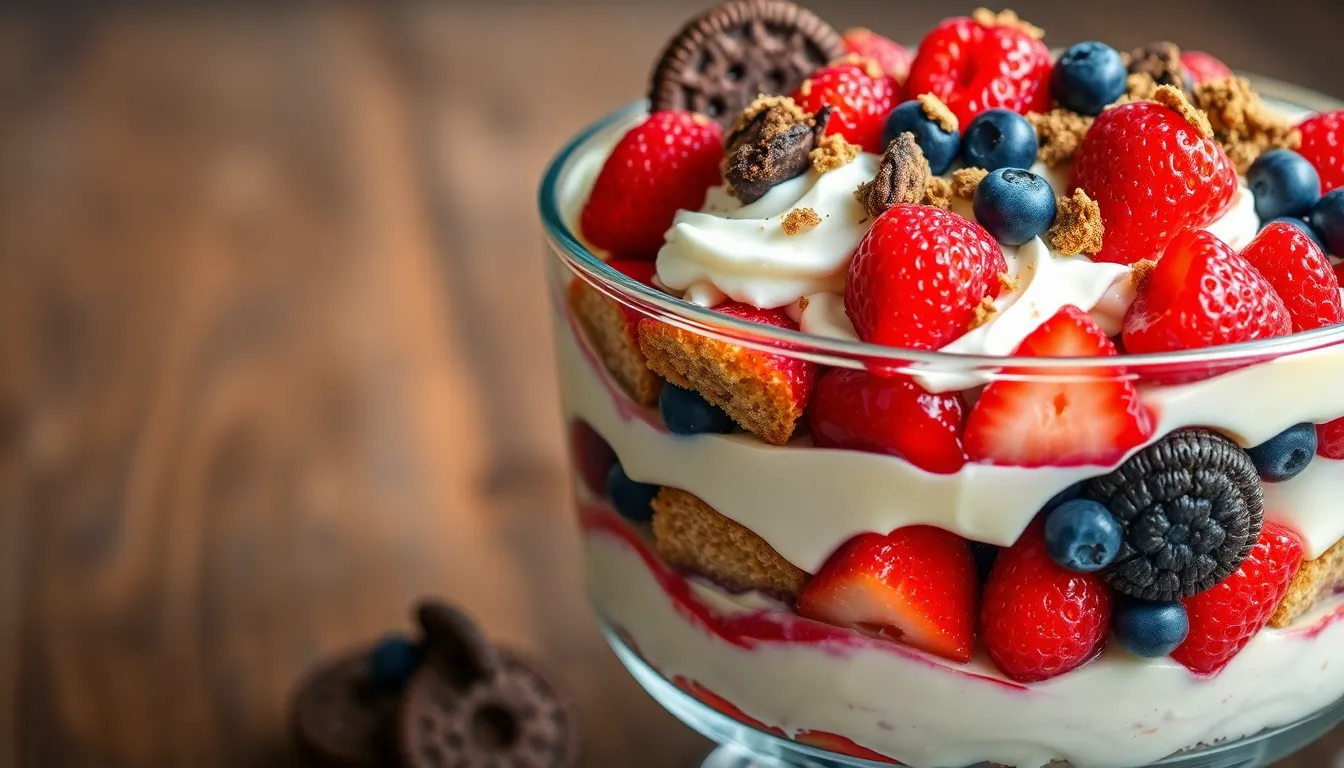
Even experienced bakers encounter challenges when making trifles. We’ll address the most common problems and provide practical answers to help you create perfect layered desserts every time.
Preventing Soggy Cake Layers
Soggy cake represents one of the most frequent trifle problems. We recommend using less liquid when soaking your cake layers to maintain proper texture. Start with just a light brush of sherry or fruit juice rather than saturating the cake completely. Allow each layer to absorb the liquid gradually before adding the next component.
Dense cakes like pound cake handle moisture better than delicate sponge cakes. We suggest choosing your cake base according to how much liquid you plan to incorporate. For alcohol-heavy trifles, opt for sturdier cake varieties that won’t break down under the weight of additional moisture.
Fixing Runny Custard Problems
Runny custard can ruin your trifle’s structure and appearance. We always ensure our custard cools completely before assembling the trifle layers. Hot or warm custard will melt whipped cream and create an unappetizing mess.
Thicken thin custard by returning it to low heat and whisking in a cornstarch slurry made from equal parts cornstarch and cold milk. Cook the mixture while stirring constantly until it reaches the proper consistency. Allow the thickened custard to cool completely before using it in your trifle.
Maintaining Stable Whipped Cream
Flat whipped cream disappoints both visually and texturally. We recommend whipping cream just before serving to maintain optimal texture and volume. Cold cream whips better than room temperature cream, so chill your bowl and beaters beforehand.
Over-whipped cream turns grainy and eventually becomes butter. We stop whipping once soft peaks form and the cream holds its shape without becoming stiff. Adding a tablespoon of powdered sugar helps stabilize the whipped cream and prevents deflation.
Managing Layer Separation
Layers that blend together create muddy-looking trifles instead of distinct beautiful layers. We place each component at room temperature before assembly to prevent temperature shock that causes layers to melt into each other. Cool custard and cream cheese fillings properly before adding them to your trifle.
Create clean layer boundaries by using a spoon to gently spread each component to the edges of your container. We avoid pressing down on layers, which can cause them to compress and merge with adjacent layers.
Balancing Flavors and Textures
Overly sweet or unbalanced trifles disappoint guests who expect complex flavor profiles. We taste each component separately before assembly to ensure proper seasoning and sweetness levels. Add a pinch of salt to overly sweet elements or incorporate tart fruits to balance rich custards and creams.
Texture contrast makes trifles interesting to eat. We combine soft custards with firmer cake layers and add crunchy elements like toasted nuts or cookie crumbs between soft layers. This variation keeps each bite captivating and prevents monotonous textures throughout the dessert.
Conclusion
We’ve explored the wonderful industry of trifles and discovered why this classic dessert continues to captivate home bakers everywhere. From traditional English versions to creative chocolate and berry variations these layered treats offer endless possibilities for customization.
The beauty of trifles lies in their forgiving nature and make-ahead convenience. Whether you’re hosting a dinner party or preparing a family dessert you can create stunning presentations with minimal stress and maximum flavor impact.
With proper storage techniques troubleshooting tips and seasonal variation ideas you’re now equipped to master this timeless dessert. We encourage you to experiment with different combinations and make these recipes your own. Your guests will be impressed by both the visual appeal and delicious taste of your homemade trifles.
Frequently Asked Questions
What is a trifle dessert?
A trifle is a classic British layered dessert featuring distinct layers of sponge cake or ladyfingers, custard or pudding, fresh or preserved fruit, and whipped cream. The layers are arranged in a transparent glass container to showcase the colorful presentation. The cake base is often soaked in sherry or fruit juice for added flavor.
Can I make trifle ahead of time?
Yes, trifles actually improve in flavor when made ahead of time. You can prepare components like cake and custard a day in advance. Assemble the trifle no more than 24 hours before serving for best results. The chilling time allows flavors to meld beautifully together.
What equipment do I need to make a trifle?
You need minimal equipment: a large glass bowl or trifle dish for presentation, individual mason jars for single servings, a sharp knife for cutting cake layers, a rubber spatula for spreading creams evenly, and a wire whisk for whipping cream. All tools are accessible to home cooks of any skill level.
What are the basic components of a trifle?
The four essential layers are: cake or sponge (sponge cake, ladyfingers, or pound cake), custard layer (homemade or prepared), fresh fruit (berries are popular), and whipped cream topping. Each component can be customized based on personal preferences and seasonal ingredients available.
How do I prevent my trifle layers from getting soggy?
Use less soaking liquid on the cake layer and choose sturdier cake types like pound cake. Ensure custard is completely cooled before assembly. Whip cream just before serving and avoid over-saturating cake layers. Allow proper chilling time between adding each layer for better structure.
What are some popular trifle variations?
Popular variations include classic English trifle with sherry, chocolate trifle with brownie layers, fresh berry trifle, lemon trifle, and individual mini trifles. You can customize with seasonal fruits, different cake bases, and various cream fillings like crème anglaise or Bird’s Custard for unique flavors.
How long can I store a prepared trifle?
Store assembled trifles in the refrigerator for up to 24 hours for best quality. Individual components can be prepared earlier: cake up to 2 days ahead, custard up to 24 hours ahead. Always cover tightly and serve chilled. Add garnishes just before serving for optimal presentation.
Can I make individual trifle servings?
Absolutely! Individual trifle cups are perfect for entertaining and portion control. Use mason jars, wine glasses, or small bowls. Popular individual varieties include “Death by Chocolate,” Red Velvet, and Berries & Cream mini trifles. They offer elegant presentation and easy serving for guests.
